
trans×form ─かたちをこえる
2013年7月27日(土)~9月16日(月・祝) 10:00-18:00 / 無料
air2013-2ja
岩崎貴宏
IWASAKI Takahiro

《リフレクション・モデル》、2013-2014
サイズ可変
シナベニヤ、檜、ワイヤー
写真:小山田邦哉
彼方の浄土への扉をひらく
服部浩之
広島に生まれ現在もこの地を拠点とする岩崎貴宏は、ケーキ屋を営んでいた自営業の父に潜在的に憧れを抱いており、自身の手で自立した生活を築くことへの意思が強く、アーティストとして生きていくことに非常に自覚的である[i]。そのような背景から大学ではデザインを学んだが、クライアントワークに不自由さを感じ、当時よく作っていた模型を何らかのかたちでそのまま作品化できないかと考え、2001年の大学院の修了制作に金閣寺をモチーフに選び、その建築が水面に反射する様子を精巧な木製模型で再現するリフレクション・モデル(fig.1)のシリーズを生み出した。その後平等院鳳凰堂をモデルとした作品(fig.2)も完成させ、今回の青森での滞在制作では、岩崎の故郷広島県の宮島の海上に浮かぶ厳島神社をモチーフとして3体目となるリフレクション・モデルの制作に打ち込んだ。
これまで岩崎はリフレクション・モデルの制作過程を公開したことはなかったが、約2ヶ月で作品を公開しなければならない状況下ですべてを展示オープンまでに完成させることは不可能であったため、ある程度かたちになった部分から段階的に制作途上の作品を公開するに至った[ii]。展覧会オープン時には本社本殿と本社拝殿のふたつの建物のみを独立させてそれぞれ天井から吊り(fig.3)、約一ヶ月後の8月20日には本社祓殿(はらえどの)を完成させ、本殿・拝殿・祓殿の三棟が接続された(fig.4)。そして展覧会終了四日前の9月12日日に祓殿前面に展開する高舞台、火焼前、楽房、門客神社が完成し、それらをつなぐ回廊とともに追加展示された(fig.5)。展覧会期中に公開できたのはここまでだったが、次期展覧会設営開始直前の9月24日には西回廊と東回廊が完成し、たった一日のみだったが追加展示され、制作ボランティアや学生に向けて公開された(fig.6)。ふたつの回廊が追加されたことでついに水平方向に延び広がる厳島神社の全容が現れた。
公開できる状態になった建物から順に展示する方法は、完成形をすぐには公開できないことに対する苦肉の策として始まったものだが、結果的にはアーティスト・イン・レジデンスならではの興味深い展開となった。制作者以外は見ることができないつくられる過程や、作品の裏側が程よく垣間見えた。展示開始後約一ヶ月は主屋の二棟が独立して設置されたため、接続部分から内部の空白が露出しており、表面のみが精巧につくられ最大限の軽量化が計られている実態が露になり、空洞の内部が不気味な存在感を放っていた。第二段階では、主要三棟が接続され、神社としての骨格は明確になった。しかし実際に厳島神社を水平に広がる回廊抜きで俯瞰的に見ることはないので、全く別の建築のようにも見えた。そして東西の回廊が加わると、そのスケール感や空間の奥行きが 劇的に変化した。それまでは建築模型としてしか認識できなかったが、作品を設置した周囲一帯がひとつの空間として鑑賞者を取り込み、作品空間をシークエンスとして経験できるようになり、豊かな風景が出現した。
リフレクション・モデルは、非常に緻密に作られているが、いわゆる建築模型とは全く異なった方法で作られるのが大きな特徴だ。建築模型は、その構造やスケールも含めトータルなデザインを検証するためにつくられるので、図面に準じて作られていく。しかし、岩崎のリフレクション・モデルは、詳細な図面を描く替わりに図鑑に掲載されている簡易な平面図や立面図と写真を収集し、その情報を総合することで目に見える建築の表面の部分を繋ぎ合わせて全体像を描出するものだ。「表面のみを忠実につくる」と本人が言うように、その内部はほぼ空洞で、目に入る表層部分のみを精密につくることに注力している。完璧な図面を入手し完璧な建築模型をつくるのではなく、入手できた情報をもとに分からない部分は想像しながらつくる。岩崎の作品において、想像しながら作る部分は非常に重要だ。見えない部分を周辺の状況から想像することで辻褄を合わせることによって、異なった合理性をもった別の建築が建ち上がる。通常建築は床下から天井まで柱は一本で通すなど、構造的合理性が重用視されるものだ。一方でリフレクション・モデルの細部を見ると、柱は床下と床上で切断されている。梁も柱と交わる部分で切断され、構造的役割は削がれている。日本建築を特徴づける屋根構造にしても表面の見えがかりは徹底的に再現されているが、それは構造のためというより、全てが装飾のような扱いで実現されている。岩崎は、水面上に建築を実現した我々の祖先の思考に想いを辿らせることでこの作品を実現した。つまり、先人が水面上に建築を実現した意図を、その美しい建物を実体だけでなく鏡像とともに眺めることで上下の方向性が消失し重力から解放された中空に浮く極楽浄土のような風景を思い描いていたのではと創造的に解釈し、建築の合理性や構造を独特に変形させることでその理想の風景を実現したのだ。古の人々が様々な苦難を乗り越え水面上に築造し、水面に浮かぶ建築を眺めることで極楽浄土の風景を脳内で再生しようと試みたその想像力に敬意を表するように、岩崎はリフレクション・モデルによって箱庭のような浄土の風景を獲得したのではなかろうか。
次に岩崎のもうひとつ代表的な作品シリーズに言及したい。岩崎は2005年まで留学していたエジンバラで、物価が高く材料を満足に買うことができない環境で、どんな状況においても制作と発表が可能な作品のあり方を探求し、身の回りのものやゴミを材料に作品を制作するようになった。ゴミなどが持つ乱雑さに秩序を見出すようになり、洗濯物の山が実際の山の稜線のように見えたり、ジャンパーからほつれ出た糸が街灯のように見えたりするなど、日常に対する解像度が非常に精彩になったことで、見立てとスケールの変換による作品の形式を築いていった[iii]。そうして生まれたのが、タオルなどの糸を抜き出して非常に小さく繊細な構造体をつくるアウト・オブ・ディスオーダー(fi.7)のシリーズだ。この試行錯誤の先に岩崎の現在のスタイルは確立された。
また、2006年から2007年にかけて母校の広島市立大学で助教を努め、アーティストで教員の柳幸典のもと学生とともに広島アートプロジェクト[iv]を立ち上げ、その一プログラムとして、かつてゴミ焼却施設だった場所を用いて「ゴミがアートになる!超高品質なホコリ」展(fig.8)という展覧会のキュレーションを手がけた。この展覧会は、岩崎のアーティストとしてのステイトメントが色濃く反映されたものだ。23組の作家が身の回りのチープなものやゴミなどを素材として制作した作品を、この建物の状況を尊重しながら設置することで建物そのものに新たな価値を与えるように融合させた展覧会で、注意して鑑賞しないと発見できない作品も多々あった。鑑賞者の想像力を刺激し眼の解像度を鍛える良展示であった。
リフレクション・モデルとアウト・オブ・ディスオーダーに明確な共通点を見出すのは容易でないと思うが、どちらも誰もが知っている日常的な風景を少しだけ異なった素材や方法で変換することで、非常に美しく繊細なある種の極楽浄土のような異世界として提示するものだ。アウト・オブ・ディスオーダーは、鉄塔や電信柱など至る所で風景の脇役として存在するものを、糸やシャープペンシルの芯など誰もがか弱いと思う素材で再現することにより、そこに儚さがもつ美しさと緊張感を与える。また、人の知覚を小さなスケールの世界に引き込むことで、何でもない周辺の風景を日常からユートピアのそれへと変換させる。一方でリフレクション・モデルは建築が持たざるを得ない重力の存在を逆説的に捉え、水面に反射する像をも実像として生み出し、中空でしか成立し得ない構造体を提示することで、建築を重力から解放し、宇宙空間に浮かぶ浄土の風景をうむ。岩崎はその作品を通じて、すぐ先にあるかもしれないユートピアへの扉を開いているのだ。存在価値がないと思われるゴミや日用品からユートピアへと私たちの意識を大きく飛ばす彼の作品群は、誰もが目指すけれども行き着けない彼方が実は此方のすぐそばにあって、目の前にある無価値と思われているものを少し違うレベルから捉える力と、その背景を丁寧に眺め想像してみる観察の視点を備えるだけで、そこにある彼方への扉は常に開かれていると気付かせてくれるのである。
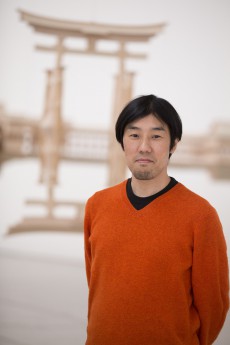
岩崎貴宏
撮影:小山田邦哉

fig.1《リフレクション・モデル》、2001
w90×d60×h115cm
檜、ワイヤー
森美術館蔵
Courtesy of the artist and ARATANIURANO

fig.2《リフレクション・モデル(極楽浄土)》、2010-2012
150x280x194 cm
檜、ワイヤー
ギャラリー オブ モダンアート、ブリスベン、オーストラリア蔵
Courtesy of the artist and ARATANIURANO

fig.3《リフレクション・モデル》、2013-2014
制作過程(7月27日-8月19日)
撮影:小山田邦哉
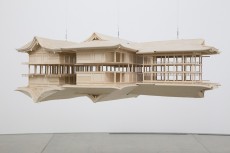
fig.4《リフレクション・モデル》、2013-2014
制作過程(8月20日-9月11日)
撮影:小山田邦哉
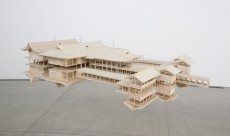
fig.5《リフレクション・モデル》、2013-2014
制作過程(9月12日-9月22日)
撮影:小山田邦哉

fig.6《リフレクション・モデル》、2013-2014
制作過程(9月23日-9月24日)
撮影:小山田邦哉
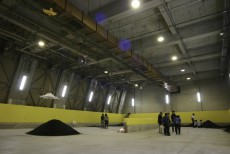
fig.7 広島アートプロジェクト2007
旧中工場アートプロジェクト
「ゴミがアートになる!超高品質なホコリ」展
旧中工場プラットフォーム、広島、2007
Courtesy of the artist

fig.8《アウト・オブ・ディスオーダー(布団)》、2010
サイズ可変
布団一式、髪の毛
Courtesy of the artist
trans×form
2013年7月27日(土)~9月16日(月・祝) 10:00-18:00 / 無料
IWASAKI Takahiro
岩崎貴宏

Reflection Model, 2013-2014
Dimension variable
Plywood, Cypress, Wire
*Work in progress. (Upgraded in August 20, September 12, 24. Completed January 22)
Photo: OYAMADA Kuniya
Opening the door to the utopia beyond
HATTORI Hiroyuki
IWASAKI Takahiro was born and is currently based in Hiroshima. Without being fully aware of it at the time, he grew up with an admiration for his father, who ran his own cake shop business.[i] Intent on building an independent life for himself, he resolutely set out to become an artist. He studied design at university but found client-oriented work restricting, so he decided to turn the models he was then frequently making into works of art themselves. He chose the Golden Pavilion as the subject of his graduate school final project in 2001, and his Reflection Model series began with an elaborate wooden recreation of the pavilion and its reflection in the water (fig. 1). His next model was of Byodoin Temple’s Phoenix Hall (fig. 2). During the Aomori residency program, Iwasaki devoted himself to a third reflection model, this time focusing on Itsukushima Shrine, which floats on the sea surrounding Miyajima Island in his native Hiroshima Prefecture (fig. 3).
Iwasaki had never before put the creative process for the Reflection Model series on view and, since he could not complete it with an entirely open creation process in the roughly two months until the exhibition began, he only presented the Itsukushima Shrine model in stages as a work-in-progress once parts had reached a certain level of completion.[ii] At the opening, only the Main Pavilion’s Main Sanctuary and Hall of Worship were on display, suspended independently from the ceiling (fig. 3). By August 20th, roughly one month later, the Main Pavilion was complete, and the Main Sanctuary, the Hall of Worship, and the Purification Hall were joined together (fig. 4). On September 12th, four days before the final day of the exhibition, the High Stage, the West-end Wooden Deck, the Music Hall, and the Kadomarodo Shrine at the front of the Purification Hall were finished and attached to the main structure with the corridor that links them (fig. 5). While these were the only segments on display during the exhibition, on September 24th, just before the start of the setup for the next show, the West and East Corridors were added and displayed for one day to students and other volunteers who assisted in the model’s production (fig. 6). With the addition of these two corridors, Iwasaki’s recreation of the horizon-spanning Itsukushima Shrine at last appeared in its full form.
This method of exhibiting segments of the model in the order of when they could be displayed began as a matter of necessity since Iwasaki was unable to present the entire model immediately. Ultimately, however, this approach made for the kind of fascinating exhibition only an artist-in-residence can offer, providing a glimpse into the process and behind-the-scenes usually seen only by an artwork’s creator. For instance, the separation of the Main Pavilion’s two major buildings left the model’s empty interior exposed for the month or so after the exhibition opened; with only the exterior recreated in detail and the structure built to be as light as possible, the hollow interior emanated a strange ambiance in its exposed state. The framework of the shrine became clear once the three main buildings were connected in the second stage of the exhibition, but until then the absence of the expansive horizontal corridors, combined with the ability to view the entire structure at once, made it appear strikingly different to the actual Itsukushima Shrine. The sense of scale and spatial depth changed dramatically once the East and West Corridors were added, as until then the work was recognizable only as an architectural model. Now a full landscape appeared, the entire exhibition environment drawing the viewer in as a single space so it could be experienced as a sequence of works.
The works in the Reflection Model series are made with extreme precision, and yet one of their major trademarks is that they are built by a method differing entirely from that of architectural models. Architectural models are created as studies of a building’s total design, including its structure and scale, and are constructed according to a blueprint. Rather than depicting a detailed blueprint, Iwasaki instead collects simplified floor plans, elevation views, and photographs from illustrated reference books, and by synthesizing them produces a complete image out of conjoined segments of the recognizable building’s exterior. Iwasaki refers to this approach as “faithfulness only to the surface.” He leaves the interior almost entirely hollow so he can concentrate just on reproducing the façade exactly. Rather than using precise blueprints to build perfect architectural models, he creates his works while using his imagination for the parts he does not know, based on information he has obtained. This element of the process is extremely important—by envisioning the unseen parts of buildings according to the peripheral information, everything can be fitted together, building up a separate architecture with a distinct logic.
Conventional architecture focuses on structural logic, as seen in practices such as the extension of a single pillar from the floor to the ceiling. In contrast, a close look at Iwasaki’s models reveals their pillars to be separated above and below the floors. Severing beams and pillars at their intersecting points lessens their structural roles. While Iwasaki’s models exhaustively reproduce the exterior even down to the Japanese-style roofs, this is not for structural purposes, but everything is realized in an ornamental way.
Iwasaki built his models by retracing the ideas of our ancestors who created these works of architecture on water. He creatively interpreted these predecessors’ designs that realized architecture on the water as landscapes that depicted not only beautiful buildings but also, by gazing at the mirror images, the vertical orientation disappears, forming visions of utopia floating in mid-air and freed from gravity. He achieved these ideal scenes through unique transformations of architectural logic and structure.
The Reflection Model series expresses respect for the imaginations of people long ago who overcame numerous hardships to build on top of the water, an attempt to recreate the landscape of utopia within their own minds by gazing at architecture that floats on the surface of water. Iwasaki’s models seem to capture these visions of utopia in miniature.
I would like now to look at another of Iwasaki’s representative series. Until 2005, Iwasaki had been studying in Edinburgh, where high prices prevented him from buying all of the art supplies he desired. As a result he pursued art he could create and display regardless of such external factors, and began using common items and trash as materials in his works. He learned to find order in the chaos of trash, envisioning an actual mountain ridge in a mountain of laundry and the shape of streetlights in the frayed threads of jackets. With an ultra-vivid filter on the everyday, he developed an artistic approach based on transformations of perception and scale.[iii] This approach culminated in the extremely delicate structures made of towel threads in his Out of Disorder series (fig. 7). From there he developed his current style through a process of trial and error.
In 2006 and 2007, Iwasaki worked as an assistant professor at Hiroshima City University, his alma mater. Along with students and the professor and artist YANAGI Yukinori, he launched the Hiroshima Art Project[iv] and as part of this curated the exhibition Trash Becomes Art! Super High-Quality Dust at the site of a former waste incinerator plant (fig. 8). This exhibition strongly reflected Iwasaki’s message as an artist. Presenting works by 23 individuals and groups made from readily available and inexpensive items or trash, it brought new value to the waste plant by integrating the works into the site as it was. Many of the works could only be spotted with close attention, which stimulated the imagination and sharpened the observational skills of the viewer.
It is difficult to identify obvious similarities between the works of Reflection Model and Out of Disorder. However, we can say that both series use materials and methods just slightly different from those common to everyday life to transform ordinary scenes into alternate worlds resembling supremely beautiful and delicate forms of utopia. Using delicate materials such as thread and mechanical pencil lead to recreate electricity towers, telephone poles, and other familiar structures that play supportive roles in our lives, Out of Disorder grants these objects a beauty and intensity inherent in their fragility. These works draw our powers of perception into miniaturized worlds in which unremarkable peripheral scenes are transformed from the quotidian into the utopian. On the other hand, the Reflection Model series offers a paradoxical take on gravity as a force indispensable to architecture, and by recreating water-reflected images as actual ones and presenting structures that can only exist in mid-air, it frees architecture from gravity and creates an otherworldly scene floating in space. Through these works Iwasaki is opening the door to the utopia of the not-so-distant future. These revelationary works take us from trash and everyday items that seem to have no great existential value into utopia, allowing us to realize that the utopia we long for but cannot seem to grasp is in fact within reach. Iwasaki’s creations teach us that if we would only perceive the ostensibly worthless things before us on a slightly different level and survey their scenes with proper imagination, the doors to utopia within them are always open.
(Translated by Hanare x Social Kitchen Translation)
***
Photos of the works made in ACAC
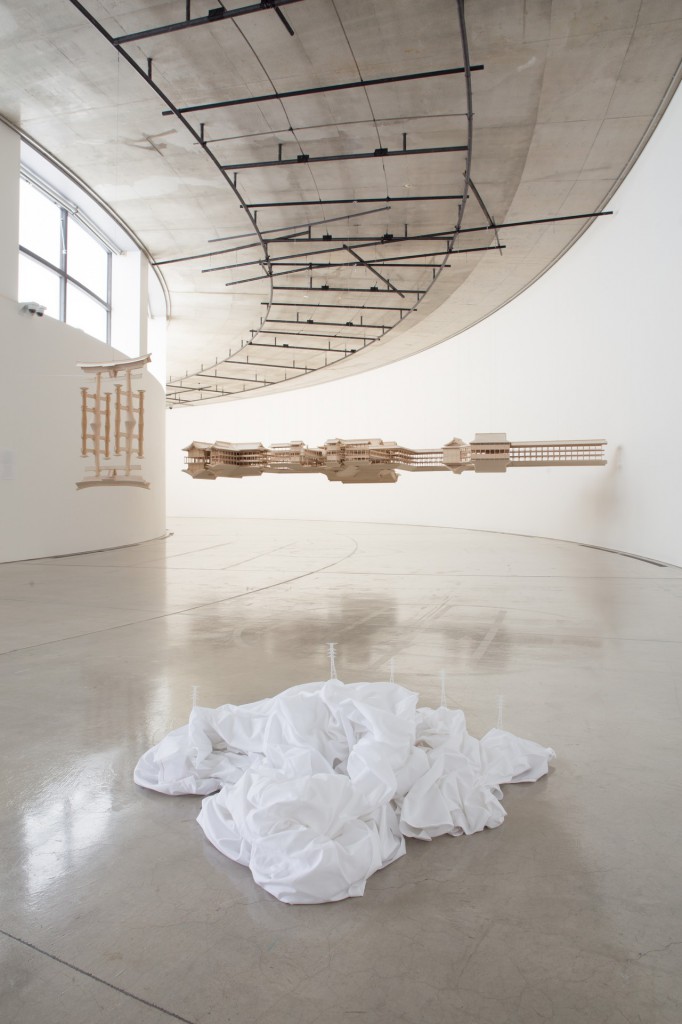 Exhibition view
Exhibition view
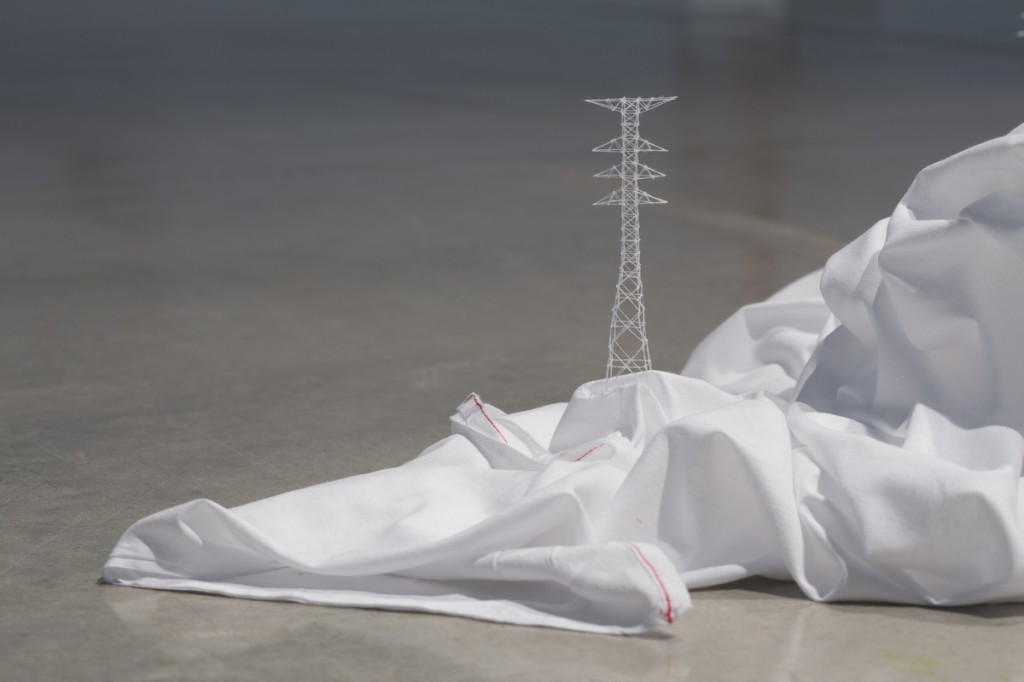 Out of Disorder, 2013
Out of Disorder, 2013
Dimension variable | Linen
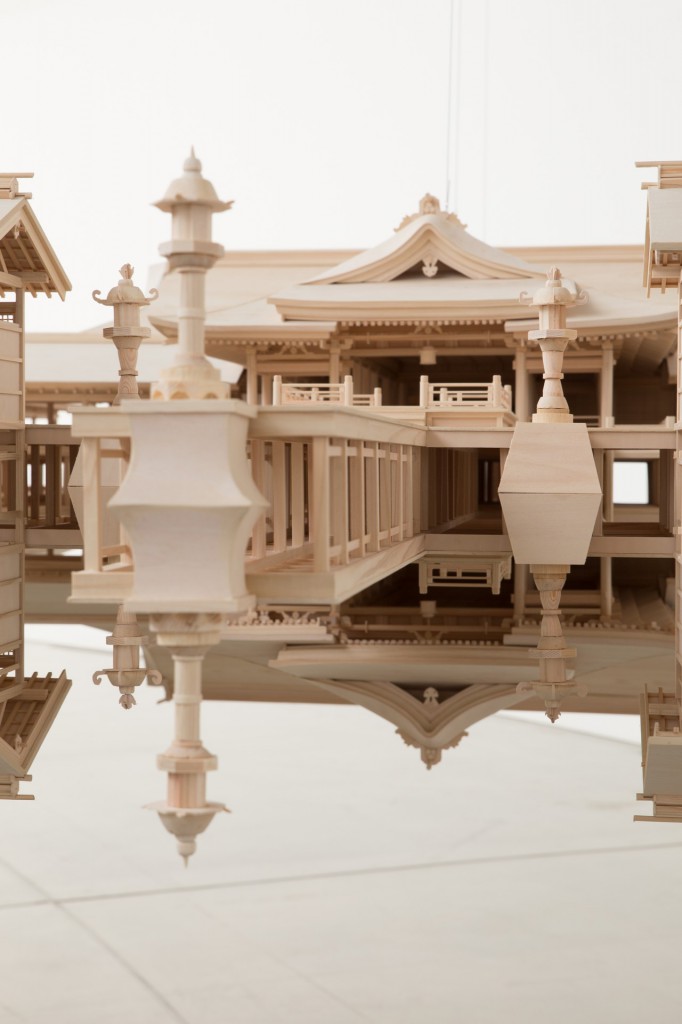
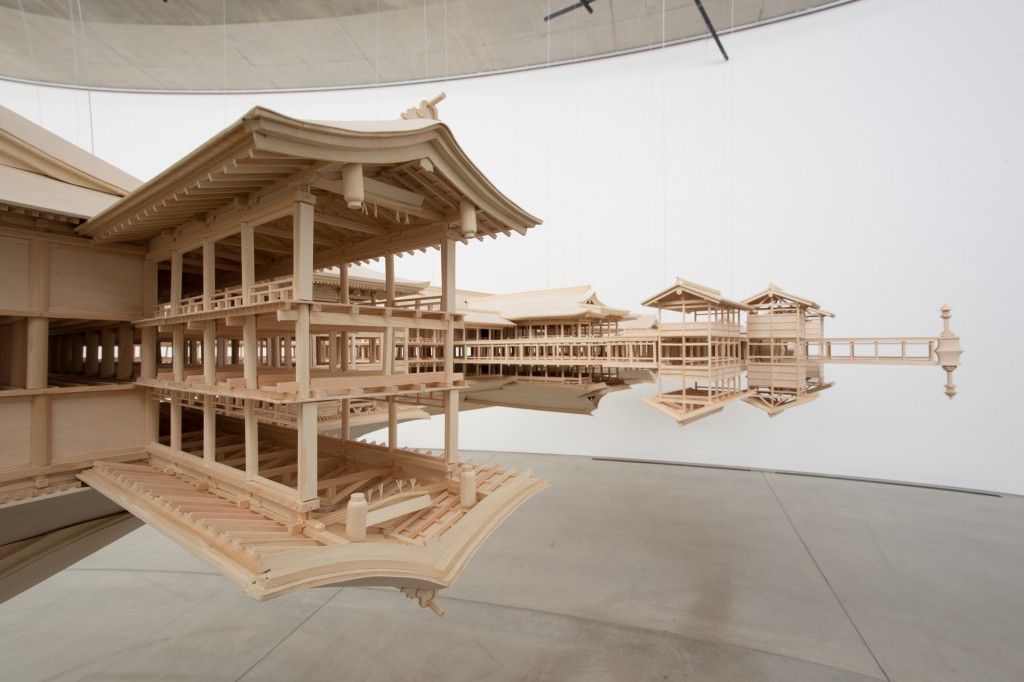
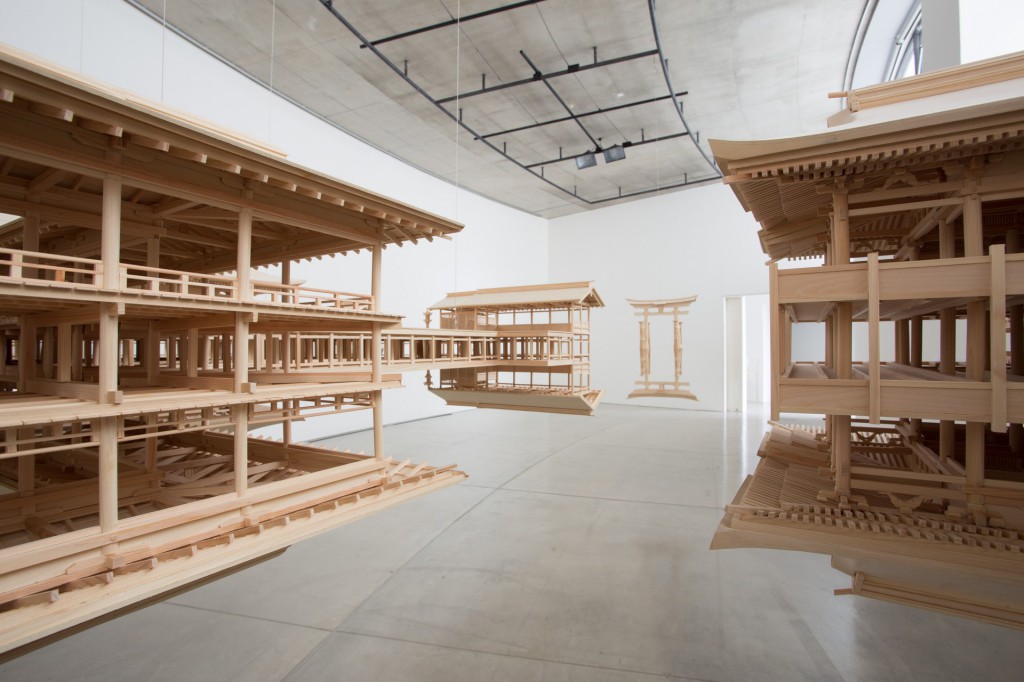
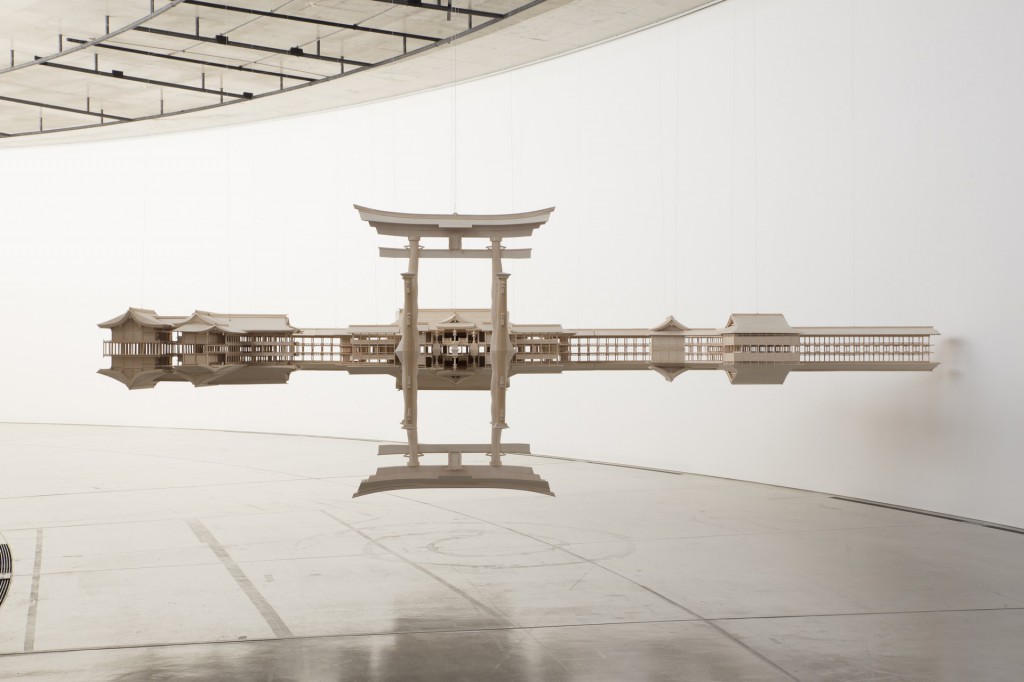 Reflection Model, 2013-2014
Reflection Model, 2013-2014
Dimension variable
Plywood, Cypress, Wire
Photo: OYAMADA Kuniya

IWASAKI Takahiro
Photo: OYAMADA Kuniya

fig.1 REFLECTION MODEL, 2001
w90×d60×h115cm
Japanese cypress, wire
Collection of Mori Art Museum
Courtesy of the artist and ARATANIURANO

fig.2 REFLECTION MODEL (Perfect Bliss) , 2010-2012
150x280x194 cm
Japanese cypress, wire
Collection of Gallery of Modern Art, Brisbane, Australia
Courtesy of the artist and ARATANIURANO

fig.3 Reflection Model (Itsukushima), 2013-2014
Production process (July 27 –August 19)
Photo: OYAMADA Kuniya

fig.4 Reflection Model (Itsukushima), 2013-2014
Production process (August 20 – September 11)
Photo: OYAMADA Kuniya

fig.5 Reflection Model (Itsukushima), 2013-2014
Production process (September 12 – September 22)
Photo: OYAMADA Kuniya

fig.6 Reflection Model (Itsukushima), 2013-2014
Production process (September 23 – September 24)
Photo: OYAMADA Kuniya

fig.7 HIROSHIMA ART PROJECT
Former Naka Waste Incineration Plant Project
Hi Quality Dust
Platform at the Former Naka Waste Incineration Plant, Hiroshima, 2007
Courtesy of the artist

Fig.8 Out of Disorder (Futon), 2010
Dimensions Variable
Futon, hair
